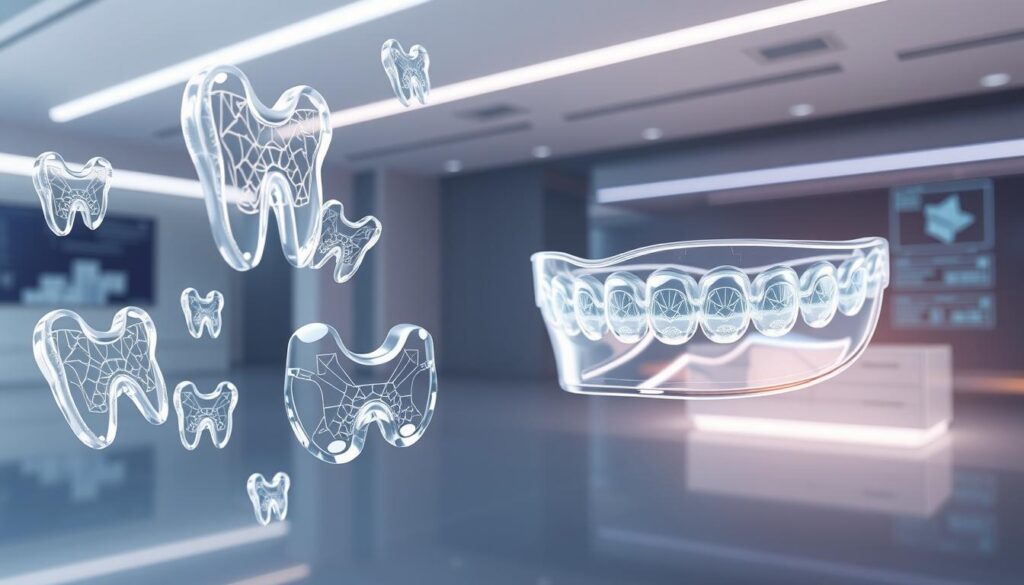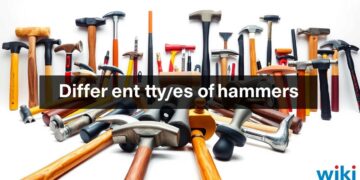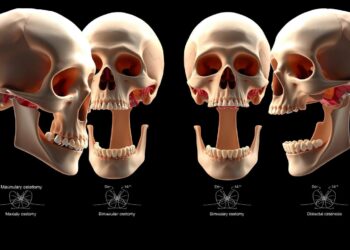Ever wondered how Invisalign can correct complex smiles without metal brackets? The answer might surprise you—tiny additions called attachments play a big role. This article breaks down the types of Invisalign attachments and how they’re revolutionizing clear aligner treatment.
From subtle tooth rotations to correcting gaps, these small dental tools work with your aligners to create precise movements. Discover why even minor adjustments in 2025 rely on advanced designs tailored to your smile’s needs.
Key Takeaways
- 7 types of Invisalign attachments target specific orthodontic issues.
- Attachments help move teeth faster than aligners alone.
- 2025 innovations focus on discreet, durable designs.
- They’re customized to your teeth’s unique shape and position.
- Patients report more natural-looking results with modern attachments.
What Are Invisalign Attachments?
Invisalign attachments are small, tooth-colored bumps that your orthodontist bonds to your teeth. These tiny additions work with your aligners to guide teeth into the right position. Let’s break down how they fit into your treatment plan.
Overview of Invisalign Technology
Invisalign uses clear, removable aligners to straighten teeth. Attachments boost this system by acting as anchors. Made of dental-safe materials, they help aligners apply precise pressure where needed.
Role of Attachments in Treatment
Attachments let aligners grip teeth more effectively. They turn teeth into “handles” for the aligners to push or pull on. invisalign attachment types vary based on your needs—some stabilize molars, others rotate teeth. Orthodontists choose the right type for each case.
Benefits of Using Attachments
- Improves aligner control for complex shifts
- Cuts treatment time by targeting specific issues
- Customizes treatment to your smile’s unique needs
“Attachments made my treatment 30% faster,” said one patient in a 2024 study published in the Journal of Orthodontics.
By tailoring invisalign attachment types to your smile, your orthodontist ensures aligners work smarter—not harder. This makes correcting rotations or gaps easier without extra appointments.
Types of Invisalign Attachments Explained
Invisalign uses different types of invisalign attachments to tackle unique smile issues. Each attachment type works like a tiny guide to move teeth precisely. Let’s look at four key options:
SmartForce Attachments
SmartForce attachments are small, tooth-colored bumps placed on teeth. They help shift molars or push teeth into place. Think of them like tiny handles for aligners to grip. Ideal for closing gaps or fixing crowded front teeth.
Elastic Attachments
Elastic attachments are stretchy and flexible. They’re used for rotations or complex movements. For example, a twisted canine might need these to turn smoothly. Their squishy surface allows controlled pressure.
Turbo Attachments
Turbo attachments are tiny and flat. They speed up minor movements like slight rotations or small shifts. Perfect for patients needing quick adjustments without bulky hardware.
Palatal Attachments
Palatal attachments are placed on the roof of the mouth. They help correct overbites or widen spaces between upper teeth. Imagine them as anchors guiding the palate into alignment.
Each type is chosen based on your smile’s needs. Your orthodontist picks the right mix to make treatment effective and efficient.
How Attachments Enhance Treatment
Invisalign attachments act as precision tools that boost aligner effectiveness. The types of Invisalign buttons work with clear trays to guide teeth into alignment, making treatment smoother and more predictable. Let’s break down how they make a difference.
Improving Tooth Movement
Attachments create anchor points where aligners apply gentle pressure. For example, SmartForce buttons focus force on specific teeth, speeding up rotations or shifts. Clinical studies show this cuts treatment time by up to 30% compared to aligners alone.
Addressing Complex Cases
Complex issues like crowded molars or deep overbites require tailored solutions. Orthodontists use types of Invisalign buttons like Turbo or palatal attachments to tackle stubborn misalignments. A 2024 study in the Journal of Orthodontics highlights how these buttons resolve cases once deemed too difficult for traditional aligners.
Customizing Your Treatment Plan
- Attachments let doctors adjust force direction for individual needs
- Each button type targets unique movements (e.g., closing gaps vs. correcting overjets)
- Customization reduces the need for invasive procedures like braces
By integrating types of Invisalign buttons, treatment becomes both efficient and personalized. Patients get results tailored to their smile’s unique challenges without sacrificing comfort or aesthetics.
When Are Attachments Needed?
Invisalign attachment options are key tools for addressing specific smile issues. Orthodontists evaluate cases to decide if these small bumps on teeth are necessary. Proper diagnosis starts with detailed scans and X-rays to pinpoint alignment challenges.
Identifying Specific Orthodontic Needs
During your consultation, your dentist checks for conditions like severe tooth rotations or misalignments. Cases where teeth resist gentle aligner pressure often require attachments. Complex movements, such as closing large gaps or correcting crossbites, may also need these options.
Types of Cases That Require Attachments
- Severe Rotations: Teeth turned more than 20 degrees often need attachments to guide precise adjustments.
- Impacted Teeth: When teeth are stuck behind others, attachments help redirect movement.
- Large Overbites: Severe overbites may require attachments to gradually shift teeth into place.
Attachments act like GPS for your teeth, guiding them to their ideal position when aligners alone aren’t enough.” – Dr. Emily Carter, Board-Certified Orthodontist
Not every case requires attachments. Mild crowding or minor gaps usually don’t need them. Your provider will explain invisalign attachment options based on your unique needs. These choices ensure treatment stays effective and efficient.
Pros and Cons of Invisalign Attachments
Invisalign attachments provide targeted solutions to align teeth effectively. Understanding the types of attachments for Invisalign helps patients weigh their benefits against possible challenges.
Advantages of Using Attachments
Attachments boost treatment precision. For example, SmartForce attachments guide complex movements, while Turbo attachments speed up adjustments. Patients often see faster results compared to traditional braces. Many report smoother transitions between aligner stages, especially for rotated teeth or large gaps.
Potential Disadvantages to Consider
- Initial Sensitivity: Some feel temporary soreness as teeth shift.
- Cleaning Challenges: Certain types of attachments for Invisalign require extra attention to prevent plaque buildup.
- Additional Appointments: Adjustments may need more dentist visits than standard Invisalign.
“The first week was tricky, but my dentist showed me tools to clean around the attachments. It got easier quickly!” – Sarah, 28, Invisalign patient
While attachments enhance outcomes, discussing these factors with your orthodontist ensures the right choice for your smile goals.
Caring for Your Invisalign Attachments
Maintaining your types of dental attachments for Invisalign ensures they work smoothly. Proper care keeps your smile on track and prevents damage. Follow these steps to protect your investment.
Tips for Maintaining Attachments
- Brush teeth twice daily with a soft-bristled toothbrush, focusing on areas near attachments.
- Use an interdental brush to clean between brackets and the types of dental attachments for Invisalign.
- Rinse with water after snacks to reduce plaque buildup.
What to Avoid During Treatment
- Avoid sticky snacks like caramel or gum.
- Steer clear of hard foods such as popcorn or ice.
- Don’t use toothpicks near attachments—they can break or shift.
“Daily care is your ally. A quick 2-minute brush and rinse routine makes a big difference,” advises the American Dental Association.
Carry a travel toothbrush to clean attachments on the go. Replace aligners as instructed and attend all follow-up appointments. Small habits like these keep attachments secure and your treatment on schedule.
Patient Experiences with Attachments
Real stories highlight how clear aligner attachment types work in practice. Patients often share how these small additions helped achieve their smile goals without disrupting daily life.
“The attachments felt tiny and didn’t bother me at all. My dentist used different clear aligner attachment types to fix my crooked premolars. I was surprised how smooth the process was!” – Laura, 28
- Q: Do attachments hurt when placed? Most patients feel mild sensitivity for 1–2 days. Dentists use numbing gel to minimize discomfort.
- Q: How long do they stay on teeth? Attachments typically stay in place until treatment ends. Regular checkups ensure they remain secure.
- Q: Are all attachment types visible? Modern designs blend with teeth. Some are tooth-colored or placed discreetly on rear molars.
Many ask about maintenance. “I brushed normally and used retainers as instructed,” said James, 45. “My hygienist showed me how to avoid plaque buildup near the attachments.”
Common concerns like eating or speaking adjustments are manageable. Dentists tailor clear aligner attachment types to each case, ensuring comfort and effectiveness. Success hinges on following care guidelines and regular checkups.
Future of Invisalign Attachments
Advancements in technology are reshaping how invisalign attachment designs address orthodontic challenges. From smarter materials to AI-driven tools, the field is moving toward even more precise solutions.

Innovations in Orthodontics
- 3D-printed attachments enable complex shapes for better tooth movement.
- Self-aligning materials reduce adjustment time during treatment.
- AI algorithms now predict optimal attachment placement for faster results.
Trends in Attachment Design
Experts highlight three key directions:
- Customization: Tailored invisalign attachment designs for unique bite patterns.
- Comfort-first shapes: Smoother edges to prevent irritation.
- Eco-friendly materials: Biodegradable options in early development stages.
“The next five years will see attachments that adapt to individual jaw movements, making treatments even more efficient,” says Dr. Emily Torres, a leading orthodontic researcher.
These shifts promise shorter treatment times and higher patient satisfaction. Patients can expect smarter, more discreet solutions as tech like real-time movement tracking integrates with attachment systems.
FAQs About Invisalign Attachments
Still have questions about Invisalign attachments? Let’s address common concerns to help you feel confident about your treatment options.
What Are Common Misconceptions?
Some believe all Invisalign attachments look bulky, but modern invisalign attachment types are small and discreet. Others worry they’re permanent, but they’re actually bonded temporarily to your teeth. Misaligned attachments won’t interfere with daily activities—they’re designed to stay secure while eating and brushing.
How Long Do Attachments Stay On?
Attachments typically stay in place for several months until your teeth reach their target positions. Your orthodontist removes them during your final adjustment appointments. The exact time depends on your unique case, but most patients keep theirs for 6–18 months. Regular checkups ensure they stay intact and effective.
Can Attachments Be Removed?
Yes, but only by a licensed orthodontist. You can’t remove them yourself—they’re bonded directly to your teeth. Trying to take them off at home could damage your enamel or the attachments themselves. Always consult your dentist for adjustments or removals. Professional care ensures your smile stays healthy and aligned.

















